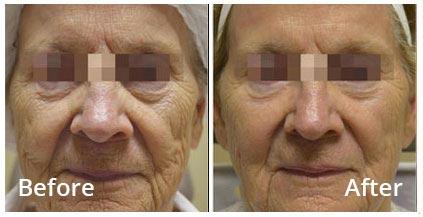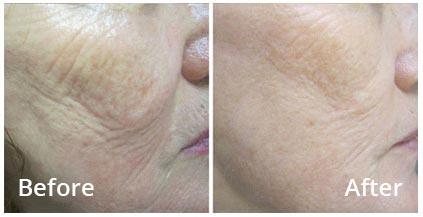Fractional Skin Resurfacing
and Rejuvenation
Fractional Wrinkle, Scar & Pigment Treatment
Scientifically proven to reduce deep wrinkles and improve skin texture on the face or body.
Whether your skin woes are the result of aging, the environment or genetics, Fractional Resurfacing uses the latest technology to rejuvenate your complexion or body for a healthy, smooth, younger looking skin. The treatment depth is customizable; providing surface, mid-depth, or deep-depth correction of wrinkles, skin laxity, stretch marks, scars, acne scars and pigmentation.
Fractional Rejuvenation is a superior treatment using RF (radiofrequency) energy to target skin imperfections, while leaving the surrounding tissue intact. This heat energy ablates (removes) damage, while stimulating the formation of collagen and elastin; the building blocks of youthful, plump, firm skin. This minimally invasive treatment provides results comparable to the best fractional CO2 lasers on moderate and deep wrinkles—with considerably less downtime and risk.
Our doctors at EverYoung look forward to helping you achieve a healthy, fresh and radiant skin that not only looks younger and smoother—but behaves younger due to an increase in collagen.
Before & After Shots


Fractional Acne Scar Treatments at a Glance

1-6 Treatments

Months

Topical Numbing Cream

Results
1-6 Treatments

of Results
Months

Topical Numbing Cream

Low

Low

90 Minutes

48 Hours

Time
90 Minutes

Work
48 Hours
Benefits of Fractional Acne Scar Treatments











Treatable Areas







FAQ
RF energy resurfaces the skin to rejuvenate your appearance, fade imperfections, and promote a clearer, smoother, more youthful and radiant appearance. Results are seen immediately, with more noticeable results seen after two weeks. Your skin will continue to improve up to three months post treatment.
Fractionated RF energy is a minimally invasive treatment using a matrix of micro-pins to resurface the skin—while heat energy revitalizes collagen in the deeper skin layers.
This is dependent on the depth of the treatment as recommended by one of our medical doctors. Surface to mid-depth treatments may only require a few days of recovery, while deep-depth treatments may require up to a week. The depth of the treatment will also determine how many treatments are needed for optimal results, ranging from 1-6.
Patients should moisturize the treated area during the healing stage and avoid direct sun exposure. Ongoing sunscreen use is highly advised to maintain your results and prevent future damage.
After fractional laser resurfacing, you can expect redness, swelling, and some peeling or crusting of the treated skin, which typically lasts for several days to a couple of weeks, depending on the intensity of the treatment.
The recovery time for fractional laser resurfacing can vary depending on the depth and intensity of the treatment but typically ranges from a few days to several weeks, during which you may experience redness, swelling, and skin peeling.
After skin resurfacing, you can expect redness, swelling, and some peeling or crusting of the treated skin, which typically lasts for a few days to several weeks, depending on the type and depth of the resurfacing procedure.
The results of laser skin resurfacing are not permanent, as the skin will continue to age, and new skin issues may develop over time; however, the procedure can provide long-lasting improvements that can be maintained with proper skincare and sun protection.
The frequency of laser skin resurfacing treatments depends on individual skin concerns and the specific type of laser used, but it is often recommended as a one-time procedure or with several years in between treatments to allow the skin to heal and rejuvenate fully.
You can typically shower after fractional laser resurfacing, but it’s important to follow specific post-treatment instructions provided by your healthcare provider and use gentle skincare products during the healing process.
The results of fractional laser resurfacing can last for several months to a few years, depending on individual factors, sun exposure, and skincare maintenance.
You can usually wash your face gently with a mild cleanser and lukewarm water within the first 24 hours after fractional laser resurfacing, following your provider’s instructions, but avoid hot water and harsh scrubbing during the initial healing phase.
Common side effects of fractional laser resurfacing can include redness, swelling, peeling, crusting, and temporary changes in skin pigmentation, although these usually resolve over time.
After fractional laser resurfacing, it’s often recommended to sleep with your head elevated to minimize swelling and avoid sleeping on your face to protect the treated skin.
The benefits of fractional laser resurfacing include improved skin texture, reduced wrinkles and fine lines, minimized scars, and a more even skin tone, achieved through the stimulation of collagen production and the removal of damaged skin cells.
You may start to see initial improvements in skin texture and tone within a few weeks after skin resurfacing, but optimal results typically become more noticeable after several months as collagen production continues.
You can typically wash your face after fractional laser resurfacing, following your provider’s instructions, but use gentle skincare products and avoid hot water and harsh scrubbing during the initial healing phase.
Fractional laser resurfacing treats only a fraction of the skin’s surface, leaving surrounding areas untouched, while traditional laser resurfacing treats the entire surface, resulting in more downtime and potential side effects.
Fractional laser resurfacing is generally considered safe when performed by trained professionals and following proper safety guidelines, but it may not be suitable for everyone, so consultation with a healthcare provider is essential.
Fractional laser resurfacing targets small, precise areas of skin, leaving surrounding tissue intact for quicker healing and reduced downtime, whereas traditional laser resurfacing treats the entire skin surface, resulting in longer recovery but potentially more dramatic results.
After laser resurfacing, take care of your face by keeping it clean with mild cleansers, applying prescribed ointments or creams, and protecting it from sun exposure by using sunscreen and avoiding direct sunlight.
Swelling after laser resurfacing can last anywhere from a few days to several weeks, depending on the depth and intensity of the treatment.
You can typically wash your face after laser resurfacing, following specific post-treatment instructions provided by your healthcare provider, but use gentle skincare products and avoid hot water and harsh scrubbing during the initial healing phase.
Itching after laser resurfacing can persist for several days to a few weeks during the healing process but should gradually subside as the skin heals.
After laser resurfacing, it’s often recommended to sleep with your head elevated to minimize swelling and avoid sleeping on your face to protect the treated skin.
You can typically shower after laser resurfacing, but it’s important to follow specific post-treatment instructions provided by your healthcare provider and use gentle skincare products during the healing process.
The extent of skin peeling after fractional laser resurfacing can vary depending on individual skin types and the specific laser settings used; not everyone will experience noticeable peeling.
The cost of laser resurfacing in the Philippines can vary widely depending on the type of laser used, the size of the treated area, and the clinic, but it typically ranges from PHP 5,000 to PHP 30,000 or more per session.
Laser technology can be expensive to implement and maintain, limiting its accessibility for some applications.
The ideal age for laser resurfacing varies depending on individual skin concerns, but it is often recommended for individuals in their late 30s to 60s when signs of aging and skin damage become more prominent.
The number of fractional laser treatments needed varies depending on the specific skin concern and the type of laser used, but a typical course may range from 3 to 5 sessions spaced several weeks apart for optimal results.
Laser resurfacing typically removes a fraction of a millimeter to a few millimeters of the outermost layers of skin, depending on the depth of the treatment and the specific laser technology used.
While laser resurfacing can improve the appearance of scars, there is a possibility that scars may reoccur or new ones may form over time due to factors like sun exposure and genetics.
The purpose of laser resurfacing is to improve skin texture, tone, and appearance by removing damaged or aged skin layers and stimulating collagen production.
Yes, laser skin resurfacing can make you look younger by reducing wrinkles, fine lines, and improving skin texture and tone.
The best laser resurfacing procedure depends on individual skin concerns, but fractional CO2 and Erbium YAG lasers are commonly considered effective options for various skin rejuvenation goals
After fractional laser treatment, it’s essential to follow post-care instructions, which typically include keeping the skin clean, applying prescribed ointments or moisturizers, avoiding sun exposure, and using sunscreen to protect the treated area.
The best moisturizer after laser resurfacing is typically a gentle, fragrance-free, and hypoallergenic product recommended by your dermatologist, as individual skin needs may vary.
It’s generally advisable to avoid strenuous exercise for at least 48 hours after laser resurfacing to minimize the risk of post-treatment complications like increased swelling or irritation.
You can typically use vitamin C after laser resurfacing, but it’s essential to consult with your dermatologist to ensure the timing and specific products are suitable for your post-treatment skincare routine.
To alleviate itching after laser resurfacing, your dermatologist may recommend using prescribed creams, avoiding scratching, and keeping the treated area moisturized and protected with gentle skincare products.
You can typically use sunscreen immediately after laser resurfacing as long as it’s a gentle, hypoallergenic, and non-irritating sunscreen recommended by your dermatologist.
Fractional laser treatments can help reduce the appearance of dark spots and hyperpigmentation by targeting and breaking down the pigmented cells in the skin, but multiple sessions may be required for significant improvement.
The number of fractional laser treatments an individual can have depends on their specific skin concerns and their dermatologist’s recommendations, but typically, a series of 3 to 5 treatments is common, with maintenance sessions as needed.
One session of fractional laser may provide some improvement, but multiple sessions are usually needed to achieve optimal results for various skin concerns.
Yes, fractional laser treatments can help brighten the skin by reducing hyperpigmentation, sun damage, and improving overall skin tone and texture.
Visible results from fractional laser treatments can often be seen after the first session, but optimal and more significant results typically become noticeable after a series of 3 to 5 sessions spaced several weeks apart.
The number of fractional laser sessions required to improve scars varies depending on the type and severity of the scars, but multiple sessions, often ranging from 3 to 5 or more, may be needed to achieve significant improvement.
After fractional laser treatment, it’s important to avoid sun exposure, harsh skincare products, and picking or scratching the treated area to promote proper healing and reduce the risk of complications.
After laser treatment, it’s generally advisable to avoid spicy foods, alcohol, and excessive caffeine, as they can potentially irritate the skin and disrupt the healing process.
The downtime for fractional facial laser treatments typically ranges from a few days to two weeks, depending on the depth of the treatment and individual skin response, during which you may experience redness, swelling, and peeling.
The healing process after fractional laser treatment usually takes around 5 to 7 days for the initial recovery, although complete skin regeneration and resolution of redness may take several weeks to months.
Skin healing after fractional laser treatment typically takes about 5 to 7 days for the initial recovery, but full recovery and optimal results can take several weeks to months as the skin continues to improve and regenerate.
It’s generally recommended to wait at least 24 hours after a laser treatment before taking a gentle, lukewarm shower to avoid exposing the treated area to excessive moisture and potential irritation.
The duration of results from skin resurfacing varies depending on factors such as the specific procedure, skincare maintenance, and individual skin aging, but they can last from several months to several years.
Book an
Appointment

ALL SERVICES
- Acne treatment
- BBL- IPL Photofacial
- Body Fx
- Botox
- Coolsculpting
- Dermal Fillers
- Morpheus8
- Sylfirm X
- Sofwave
- Fotona StarWalker®
- Fractora
- Hair Loss / Balding
- Hydrafacial MD
- Laser Hair removal
- Alma Harmony® XL Pro
- Alma Harmony® XL Pro ClearLift™
- Alma Harmony® XL Pro Dye VL Laser
- Lip augmentation
- Laser Genesis
- Microdermabration
- Microneedling
- Non-surgical Facelift
- Pigmentation Treatment
- PDRN Salmon DNA
- Picosure
- Prp Blood Facial
- Red and vessels treatment
- RF Collagen Induction
- Ultherapy
- Thermage
- Thermage® CPT™
- Thermage® FLX
- Vaginal Rejuvenation


